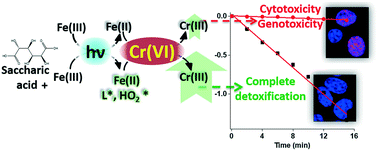Photochemical detoxification of Cr(vi) using iron and saccharic acid: insights from cytotoxic and genotoxic assays†
Abstract
Herein, we demonstrate rapid and complete photochemical detoxification of Cr(VI) by iron using saccharic acid (SA) as a sacrificial organic agent. 100% Cr(VI) (200 μM) was reduced within 30 min using Fe(III) (50 μM) and SA (300 μM) under UV irradiation. The reaction mechanism involves photochemical recycling of Fe(III)/Fe(II) by SA via ligand to metal charge transfer (LMCT) along with the generation of a concomitant ligand radical and hydroperoxyl radical. Importantly, the MTT assay and γH2AX immunostaining were performed to evaluate the hitherto unexplored comparison of cytotoxicity and genotoxicity caused by untreated and treated aqueous Cr(VI). The results revealed that the Fe(III)/SA/UV treatment caused the complete removal of cytotoxic and genotoxic effects of Cr(VI) towards human cell lines. The presence of nitrate, chloride and natural organic matter increased the Cr(VI) reduction, while phosphate decreased the Cr(VI) reduction. Cu(II), Al(III) and Ni(II) had a positive effect on the Cr(VI) reduction. Furthermore, the Fe(III)/SA/UVC treatment caused almost complete Cr(VI) reduction in groundwater, lake water, and simulated galvanic wastewater. This study strongly supports the aptness of the Fe(III)/SA photochemical system for detoxification of Cr(VI) contaminated wastewater.



 Please wait while we load your content...
Please wait while we load your content...